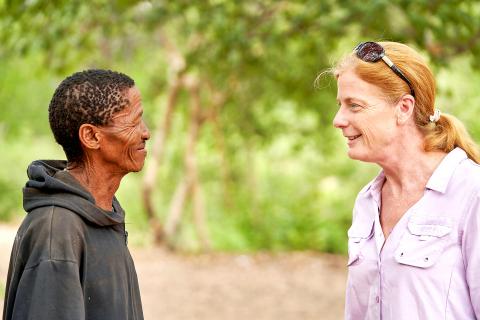A large ancient wetlands region spanning northern Botswana — once teeming with life but now dominated by desert and salt flats — may represent the ancestral homeland of all of the 7.7 billion people on Earth today, researchers said on Monday.
Their study, guided by maternal DNA data from more than 1,200 people indigenous to southern Africa, proposed a central role for this region in the early history of humankind starting 200,000 years ago, nurturing our species for 70,000 years before climate changes paved the way for the first migrations.
A lake that at the time was Africa’s largest — twice the area of today’s Lake Victoria — gave rise to the ancient wetlands covering the Greater Zambezi River Basin that includes northern Botswana into Namibia to the west and Zimbabwe to the east, the researchers said.

Photo: REUTERS
照片:路透
It has been long established that Homo sapiens originated somewhere in Africa before later spreading worldwide. “But what we hadn’t known until this study was where exactly this homeland was,” said geneticist Vanessa Hayes of the Garvan Institute of Medical Research and University of Sydney, who led the study published in the journal Nature.
The oldest-known Homo sapiens fossil evidence dates back more than 300,000 years from Morocco. The new study suggests that early members of our species, as represented by the Morocco remains, may not have left any ancestors living today, the researchers said.
“There is no contradiction between the presence of an early Homo sapiens-like skull in northern Africa, which may be from an extinct lineage, and the proposed southern African origin of the Homo sapiens lineages that are still alive,” added study co-author Axel Timmermann, a climate physicist at Pusan National University in South Korea.
The ancient lake Makgadikgadi began to break up about 200,000 years ago, giving rise to a sprawling wetland region inhabited by human hunter-gatherers, the researchers said. “It can be viewed as a massive extension of today’s Okavango Delta wetland area,” Timmermann said.
Changes in Earth’s axis and orbit caused climate, rainfall and vegetation shifts that set the stage for early migrations of this ancestral group of people away from the homeland region, first toward the northeast 130,000 years ago, then toward the southwest 110,000 years ago, Timmermann added.
“Our study provides the first quantitative and well-dated evidence that astronomically driven climate changes in the past caused major human migration events, which then led to the development of genetic diversity and eventually cultural, ethnic and linguistic identity,” Timmermann added.
(Reuters)
研究人員週一表示,橫跨波札那北部的一大片古老溼地區域──當地曾經充滿生機,現在卻遍布沙漠和鹽灘──也許就是今日地球上所有七十七億人祖先的故鄉。
這份研究參考了一千兩百多名非洲南部原住民的母系DNA資料,從而推論出,該區域在二十萬年前開始的人類早期歷史中扮演著重要角色。這片土地養育著我們物種長達七萬年之久,直到氣候變遷使人類第一次向外遷徙成為可能。
研究人員表示,非洲當時最大的一座湖──面積足足是今日維多利亞湖的兩倍大──形成一大片古老的溼地,涵蓋整片大尚比西河流域,範圍包括波札那北部,向西延伸到納米比亞,向東延伸到辛巴威。
長久以來,科學界早有定論:「智人」起源於非洲某處,後來才擴展到世界各地。澳洲雪梨大學和嘉文醫學研究所的遺傳學家凡妮莎‧海斯,是這篇發表於期刊《自然》的主要作者。她指出:「但是一直到這份研究之前,我們所不知道的是,這個人類原鄉到底位於何處。」
目前已知最古老的智人化石證據可追溯到三十多萬年前,於摩洛哥出土。研究人員表示,這項新研究指出:摩洛哥遺骸所代表我們物種的早期成員,也許並沒有存活下來,成為今日人類的祖先。
南韓釜山國立大學的氣候物理學家阿克塞爾‧提默曼是這篇研究的共同作者。他補充指出:「在北非出現的早期類智人頭骨,也許是來自於一脈已經滅絕的世系,而這份研究提出的智人世系起源於非洲南部,且持續繁衍至今,兩者之間互不牴觸。」
研究人員指出,遠古湖泊「馬卡迪卡迪」大約在二十萬年前開始分裂,形成持續向外蔓延的溼地區域,狩獵採集為生的人類當時就棲息於此。提默曼表示:「可以把它想像成今日奧卡萬戈三角洲溼地區域的巨大延伸。」
提默曼補充說,地軸和地球軌道的改變導致氣候、降雨以及植被發生變化,為這群人類祖先創造出早期遷徙的條件。他們離開家鄉,先在十三萬年前向東北方移動,再於十一萬年前向西南方遷徙。
提默曼指出:「我們的研究提供首次經過量化並仔細定年的證據,顯示過去由天文變化導致的氣候變遷引發大規模的人類遷徙事件,進一步造成遺傳多樣性的發展,最後形塑出文化、種族以及語言等身分認同。」
(台北時報章厚明譯)

The content recommendation algorithm that powers the online short video platform TikTok has once again come under the spotlight after the app’s Chinese owner ByteDance signed binding agreements to form a joint venture that will hand control of operations of TikTok’s US app to American and global investors, including cloud computing company Oracle. Here is what we know so far about its fate, following the establishment of the joint venture. IS BYTEDANCE CEDING CONTROL? While the creation of this new entity marks a big step toward avoiding a US ban, as well as easing trade and tech-related tensions between Washington and Beijing, there

A: Happy New Year! I can’t believe it’s 2026 already. Where did you count down? B: I went to pop singer A-mei’s Taitung concert yesterday for the New Year’s countdown. How about you? A: I went to rock band Mayday’s Taichung concert yesterday. Going to their New Year’s shows has become a holiday tradition for me. B: Don’t forget, we’re also going to Jolin Tsai’s show tonight. It’s her first perfomance at the Taipei Dome. A: Yeah, that’s right. It’s great to start the year with good friends and good music. A: 新年快樂!我真不敢相信都已經2026年了。你昨天去哪跨年啦? B: 我昨天去了流行天后張惠妹的台東演唱會,還和她一起跨年倒數。那你呢? A:

Prompted by military threats from Russia, Denmark has recently passed a new conscription law, officially including women in its military draft for the first time. From July 1, 2025, Danish women, upon turning 18, will be entered into the draft lottery. If selected, they are to serve in the military for 11 months, just as men do. Not only has this decision attracted international attention, but it has also sparked discussions on gender, equality and national defense. Although Denmark’s reform appears to promote gender equality, it primarily responds to regional instability and the need to strengthen national defense. With

A: Apart from Taiwan’s A-mei, Mayday and Jolin Tsai, there are many foreign singers coming to Taiwan early this year. B: The South Korean girl group Babymonster are playing two shows at Taipei Arena starting from tonight. Who else is coming to Taiwan? A: Other artists include Australian band Air Supply, K-pop superstar Rain, boy group Super Junior, TXT, US singers Giveon and Josh Groban, and Irish boy group Westlife. B: Air Supply was the first foreign band to come to Taiwan in 1983, and they’re probably the most frequently visiting group too. A: As the year is beginning